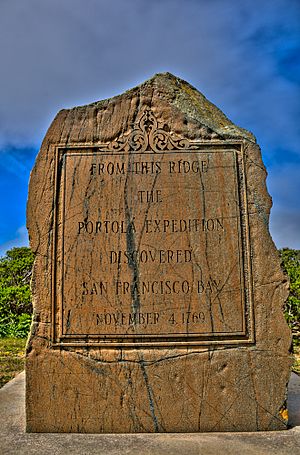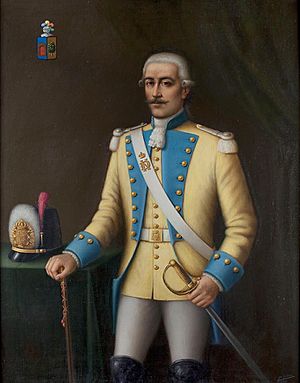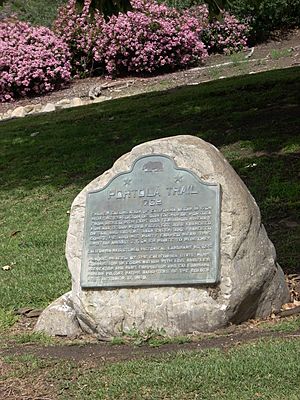Portolá expedition facts for kids
The Portolá expedition (Spanish: Expedición de Portolá) was a Spanish journey of exploration. It happened in 1769–1770. This was the first time Europeans explored the land inside what is now California, USA.
The expedition was led by Gaspar de Portolá. He was the governor of Las Californias. This was a Spanish area that included California, Baja California, and parts of today's Mexico and the United States. This trip helped Spain claim more land along the Pacific coast of North America.
Contents
Why the Expedition Happened
Even though Native Americans already lived there, Spain claimed the land that is now California in 1542. This happened when Juan Rodríguez Cabrillo explored the Pacific Coast. Later, in 1579, Francis Drake claimed some of the same coast for England.
Other explorers like Sebastián Vizcaíno also mapped parts of the California coast in 1602. He found places like San Diego and Monterey. But after Vizcaíno, Spain didn't do much to settle this area for over 160 years. They were busy with problems in Europe.
Then, in 1767, the King of Spain, Charles III of Spain, kicked out the Jesuit missionaries from his kingdom. Gaspar de Portolá was chosen to be the new governor of Las Californias. He was sent to replace the Jesuits with Franciscan missionaries. Portolá was a military officer. He brought soldiers with him to help with the changes and to explore more of California.
Spain's Decision to Explore
By the late 1760s, European rulers realized how important the Pacific coast of North America would be for trade. The Russians were moving south from Alaska. The British were moving west in Canada.
To protect Spain's land, King Charles III of Spain wanted to explore and settle the coast. He wanted to create a "buffer zone" to keep other countries from invading.
José de Gálvez, a Spanish official, organized the expedition. He put Governor Portolà in charge. The plan was to travel both by land and by sea up the Pacific coast. The ships would bring supplies to the land group.
The expedition's main goal was to find the "port of Monterey" that Vizcaíno had described. They also wanted to find "San Francisco Bay" further north. They hoped to claim the area for Spain and see if the bay would be a good port.
The Journey Begins
The expedition started with five groups. They all left from Baja California and headed north to San Diego. Three groups traveled by sea, and two by land.
Traveling by Sea
Three ships were quickly built: the San Carlos, the San Antonio, and the San José. They sailed for San Diego in early 1769.
On January 9, 1769, the San Carlos set sail. On board were Captain Vicente Vila, Lieutenant Pedro Fages with 25 soldiers, and Miguel Costansó, who made maps. Friar Fernando Parrón was the chaplain.
On February 15, the San Antonio left. It was captained by Juan Pérez. Franciscan friars Juan Vizcaíno and Francisco Gómez were chaplains.
The San José was a supply ship. It never reached San Diego and was lost at sea.
Traveling by Land
Captain Fernando Rivera led the first land group. He gathered horses and mules from missions in Baja California. Friar Juan Crespí was the diarist for this group. They left Velicatá on March 24. This group included 25 soldiers and 42 Christian Native Americans from Baja California.
Portolà himself led the second land group. They left Loreto on March 9. Junípero Serra, who was in charge of the Franciscan missionaries, joined Portolà's group as a chaplain and diarist. Serra had a bad leg, but he insisted on going. This group had 25 soldiers, muleteers, and 44 Christian Native Americans.
Reaching San Diego
The ships arrived in San Diego first. The San Antonio arrived on April 11, and the San Carlos on April 29, 1769. Many sailors on both ships got very sick, mostly from scurvy. They set up a camp on the beach and made hospital tents for the sick. Many men died every day.
Captain Rivera's land group arrived on May 14. They had traveled 300 miles (480 km) in 50 days. They didn't lose anyone or have anyone get sick. Rivera's men moved the camp inland, building a new one on a hill. This place is now known as Old Town, San Diego.
On July 1, Portolà's land group arrived in San Diego. They were in good health and brought many supplies. After everyone reunited, Friars Juan Vizcaíno and Fernando Parrón stayed in San Diego with Junípero Serra to start the new Mission San Diego de Alcalá. Friars Juan Crespí and Francisco Gómez continued north with Portolà.
Serra's group wanted to build Catholic missions to teach Christianity to the Native Americans. Crespí was the only one who traveled with the land expedition the whole time, so he wrote the official diary for the missionaries.
Journey to San Francisco
After resting for two weeks, Portolà continued north. His goal was to find Monterey Bay by land. The group had 74 men, including soldiers, scouts, and Native Americans. Friar Juan Crespí was the official diarist. On July 14, 1769, the Portolà party left San Diego. Serra stayed behind to establish Mission San Diego de Alcalá.
Earthquakes Near Los Angeles
On July 28, the group reached a big river in southern California. They called it the Santa Ana River. That afternoon, they felt a strong earthquake. Aftershocks continued for several days. On August 2, they traveled west to a river that Crespí named El Río de Nuestra Señora la Reina de los Ángeles de Porciúncula. This is where the city of Los Angeles would later be built. They continued northwest along a path that would become El Camino Real (the royal road).
Missing Monterey Bay
On September 30, the scouts reached Monterey Bay. But they didn't recognize it as the port that Sebastián Vizcaíno had described 167 years earlier. The rest of the group reached Monterey Bay on October 1. They still didn't recognize it because it didn't seem as grand as Vizcaíno had said. Also, Portolà and his hungry men hoped to find the supply ship San José waiting for them. But the ship was lost at sea.
The group continued north on October 7. Many men were sick with scurvy.
Discovering San Francisco Bay
On October 30, they reached the coast near today's Moss Beach. They could see the Farallon Islands and Drakes Bay. This made some of them think they had passed Monterey.
Sergeant José Francisco Ortega and his scouts went ahead. They found their way blocked by a huge bay they couldn't identify. This is now known as San Francisco Bay. Ortega and his scouts explored the bay's west and east sides.
When the scouts returned, Portolà led the whole group to a spot where they could see the entire San Francisco Bay. Only Friar Juan Crespí seemed to understand how important the bay was. He wrote in his diary that it was "a very large and fine harbor, such that not only all the navy of our Most Catholic Majesty but those of all Europe could take shelter in it."
The Return Trip
On November 11, Portolà decided they must have passed Monterey. They agreed to turn back and return to San Diego. They headed south.
On November 28, the group crossed the Monterey Peninsula. A week later, they still didn't believe they had found Vizcaíno's port of Monterey. On December 10, Portolà ordered his men to plant a large wooden cross on a hill by the beach. They buried a letter at its base, describing their journey.
The men were very hungry. They had to eat seagulls and pelicans. Some Native Americans visited them, bringing food. The weather turned cold, and it started to snow.
The tired men reached San Diego on January 24, 1770. They were welcomed by their fellow soldiers and friars. Everyone in the party had survived their six-month journey, except for five men who had left the group. They had traveled about 1,200 miles (1,900 km). They were the first Europeans to explore San Francisco Bay and many other important places. But Friar Junípero Serra was surprised they hadn't found Monterey Bay. He told Portolà, "You come from Rome without having seen the pope!"
Second Trip to Monterey (1770)
A second expedition was planned to find Monterey Bay and build a settlement there. Portolà led a new land group from San Diego. This group was smaller than the first. It included Pedro Fages with soldiers, muleteers, and Native Americans. Friar Juan Crespí also joined again.
On April 17, the group left San Diego. They followed the same route as before. They traveled for five weeks and arrived at Monterey Bay on May 24. No one got sick or was lost.
That afternoon, Portolà, Crespí, and a guard walked to Point Pinos on the northern tip of the Monterey Peninsula. They found the large cross they had planted the previous December. It was surrounded by feathers and broken arrows. Fresh fish and meat were laid out in front of the cross. No Native Americans were in sight. In the bay, hundreds of seals and sea otters were swimming. Crespí wrote: "This is the port of Monterey without the slightest doubt."
Meanwhile, on April 16, the San Antonio ship sailed from San Diego to Monterey. Junípero Serra, Miguel Costansó, and Doctor Pedro Prat were on board. The ship faced bad winds and had to go south before heading north. Several sailors got sick with scurvy. The San Antonio finally sailed into Monterey Bay on May 31. The Portolà land party, who had arrived a week earlier, welcomed them.
They realized that the spot where they had left the cross truly overlooked the place Vizcaíno had described. Portolà founded the Presidio of Monterey on that hill. Serra founded the Mission San Carlos Borromeo nearby. On July 9, 1770, Portolà and Costansó sailed out of Monterey Bay, heading back to Baja California.
Meeting Native Americans
For the most part, the Spanish explorers had peaceful interactions with the Native American tribes in Alta California. Many tribes were welcoming and helpful. They offered guidance and supplies to the Spanish.
The Spanish wanted friendly encounters. They brought many items like glass beads to trade for supplies and to build good relationships. They carried these items instead of more food or crucial supplies. This shows they really wanted to be peaceful with the native people. Their long-term goal was to create settlements and teach Christianity, so peaceful relations were very important.
What the Expedition Achieved
The Portolà expedition was the first time Europeans explored California by land. Its most important discovery was San Francisco Bay. Almost every place they stopped along the way was a first for Europeans.
This expedition, along with the later de Anza expedition, helped create the overland route north to San Francisco. This route became known as the Camino Real (Royal Road). This road was very important for Spain to settle Alta California. It allowed the Franciscan friars to build a string of twenty-one missions. These missions became the centers of new towns. They also started cattle ranching and taught Christianity to many Native Americans.
Three diaries from the expedition still exist today. They give a very detailed look into the daily travels and experiences. One was written by Portolà himself, another by Miguel Costansó, and the most complete one by Juan Crespí.
When Portolà returned to New Spain in 1770, Pedro Fages became the lieutenant governor of Alta California. His headquarters were at the Presidio of Monterey. Fages led more trips to explore the east side of San Francisco Bay and also kept his own diaries.
Images for kids
See also
 In Spanish: Expedición de Portolá para niños
In Spanish: Expedición de Portolá para niños







